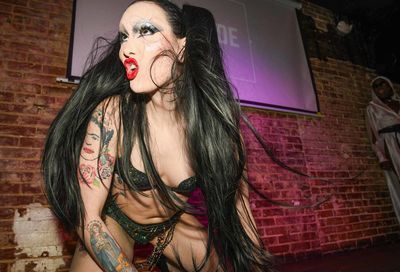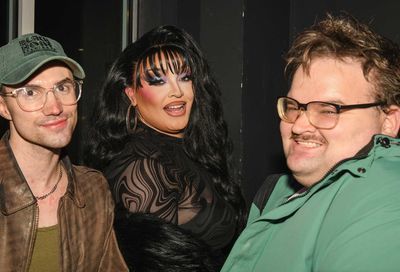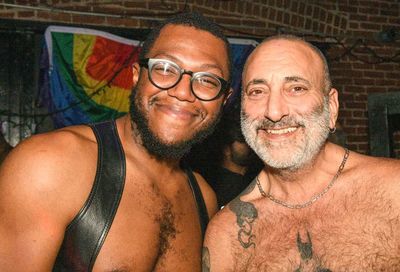Homegrown History
An exploration of the Harlem Renaissance in 'Brother to Brother' reflects D.C.'s own gay black history
The Harlem Renaissance is one of the most culturally romantic periods of American history. In a sense, it was the spark that ignited a fire of black artistic and literary expression in this country. Rodney Evans’s film Brother to Brother, first screened in D.C. during the Reel Affirmations Film Festival in October, captures some of that fire (see review). As the film returns to Washington, audiences should be reminded that though the spotlight was on Harlem, the district played its own rich role in the black arts renaissance of the early 20th century.
In his film, Evans uses GLBT stars of the Harlem Renaissance to flavor his story of a contemporary, young African American man trying to find his way in the world. Two of Evans’ brightest stars are Richard Bruce Nugent and Langston Hughes. But before writers Hughes and Nugent moved to New York together, they called D.C. home.
 Evans (Photo by Kirsty Mogansen) |
One of Nugent’s most noteworthy accomplishments is his short story, “Smoke, Lilies and Jade.” Published in 1926, it’s credited as the first story by an African American author to include same-sex themes.
Hughes, on the other hand, achieved a greater level of recognition than Nugent, while his sexual orientation is something that is still debated today.
Nugent, played by Roger Robinson, steals the show in Brother to Brother. In the film, the contemporary young man, Perry (Anthony Mackie), meets an elderly Nugent on a Manhattan stoop. Following this initial meeting, Nugent tries to help Perry deal with a general sense of defeat –family rejection, artistic ennui — with stories of the Harlem Renaissance.
 |
Evans insists Perry is not a metaphor for his own life, but there are similarities, especially in Nugent’s role a mentor.
“I had done another film, Close to Home, that dealt with a lot of my personal experiences coming of age,” Evans shares, explaining that making Brother to Brother was a six-year process. “That led me to think about how my life would be different if I’d lived in a different time. And that led me to a videotape of Bruce Nugent.”
Evans made his discovery at the New York Public Library’s Schomburg Center for Research in Black Culture. It also included approximately 30 hours of Nugent on audiotape. As with his protagonist Perry, Evans said he had been rejected by his family for being gay, and that Nugent was a voice that helped him, albeit posthumously. Nugent died in 1987.
“I think that people assume the film is a little more autobiographical than it actually is,” Evans cautions. “Perry is a mix of a lot of things. There are aspects of my life, but there are things that are completely fiction.”
Nevertheless, Evans says Perry’s rejection by his family followed Evans’ own experience, though to a less-hostile degree.
“My parents had a very difficult time with my being gay and coming out to them,” says Evans. “Mine was not as tragic or extreme as the one in the film, but I definitely got a lot of the harshness, negativity, lack of understanding from my nuclear family and the extended community. It really made me have to search out places I could call home, a makeshift community that could accept me for who I was. I wanted to stay true to that in the film.”
It may be that need to build a makeshift family that helped Evans relate to what he was gleaning from his research into Nugent. After all, Nugent, who was gay, was building makeshift communities for himself in Washington and New York, long before Evans was born.
 |
“Once I discovered Bruce [Nugent], I found him so unique, witty and wise, and mind-blowing,” says Evans. “After 30 hours of audio interviews when Bruce was in his elderly years, I developed a strong bond, a profound love for him. I almost thought of him as my doppelganger. He thought the same thoughts. Through that research, there was a kind of mentorship…. There’s this incredibly strong bond between me and Bruce. That’s how the relationship between these two artists became the heart of the story.”
Young Nugent’s world would likely have been both familiar and foreign to Evans, or any modern GLBT denizens of Washington. Some of Nugent’s D.C. landscape is still with us. One frequently overlooked spot would be 1461 S Street NW. In the 1920s, poet and playwright Georgia Douglas Johnson held Saturday night salons for African American artists and writers, according to D.C.’s Rainbow History Project.
Along with Nugent, other GLBT African Americans of the time to grace Johnson’s salon were Hughes, Angelina Weld Grimké and Alain Locke.
Locke, believed to have been gay, is a prominent character in the city’s history. A Harvard graduate, he was the first black Rhodes Scholar and joined Howard University as an assistant professor of English and philosophy in 1912, according to the D.C. Library. He remained with Howard until his retirement in 1953. Locke also took the time to groom younger members of the salon, sharing a particularly strong bond with Nugent, who would go on to illuminate the Harlem Renaissance.
 Dunbar High School (Photo by Reprinted by Permission of the D.C. Public Library; the cast of Brother to Brother) |
Grimké, a poet and playwright, flourished in D.C. She did move to New York after her father died in the 1930s, but lived there in seclusion. While being a lesbian writer anywhere in the early 20th century was not an easy sell, Grimké, according to the D.C. Library, penned Rachel, a popular play meant to counter the success of the Ku Klux Klan-friendly film, Birth of a Nation.
Along with the names synonymous with D.C.’s renaissance, there are also the places — aside from Johnson’s S Street home. Two standouts, according to Rainbow History, are the Republic Gardens and Bohemian Caverns, though the latter was Crystal Caverns during the 1920s and ’30s. These were gay-friendly hotspots of the day, and still recognizable along the U Street Corridor. Another literary landmark is Dunbar High School at New Jersey Avenue and N Street NW. Grimké was a teacher at the school, and Nugent was among her students.
Despite Washington’s own explosion of African American GLBT artistic and literary culture in the early 20th century, it’s New York’s Harlem Renaissance we recognize as the home of this unique piece of American history and culture. Mark Meinke, who founded the Rainbow History Project in 2000, has some theories.
 Langston Hughes (Photo by Reprinted by Permission of the D.C. Public Library; the cast of Brother to Brother) |
“There are several reasons why Harlem’s renaissance is better known,” Meinke offers. “New York City was obviously a much better venue for promoting and publishing literature than Washington was in the 1920s. Also, I believe I can safely say that those who moved to New York — Langston Hughes, Bruce Nugent, and ultimately Angelina Weld Grimké — were probably more literarily active and closer to the peak of their powers in the late ’20s than in the first years of the decade….
“Their artistic contributions are much more commonly identified with New York than Washington,” Meinke continues. “It can be said, without condemnation or regret, but as simple fact, that D.C.’s role has been eclipsed in accounts of the Harlem Renaissance as it has been in other GLBT accounts of civil rights struggles, responses to AIDS, and other salient points in the emerging history of the gay community.”
While the links to place and time are obvious for both the Harlem Renaissance and the similar artistic/literary movement in Washington, the role of sexual orientation may be a bit more tenuous.
An essay written by Brett Beemyn and published in Modern American Queer History in 2001 explores that angle. He looks particularly at Grimké and Nugent.
“The decade of the 1920s is often dubbed the New Negro or Harlem Renaissance because it witnessed a boom in the number of literary and artistic works produced by African Americans, particularly by the new, younger generation of African Americans who had migrated to northern and mid-Atlantic cities,” Beemyn writes. “Many critics have noted that a renewed sense of race consciousness among these emerging [b]lack writers and artists played a central role in the development of the Renaissance, but virtually ignored is the significance in some cases of a growing awareness of being attracted to both women and men. Not only were a number of the period’s leading figures behaviorally bisexual,…but this frequently had as much of an impact on their lives as being African American. And while the New Negro Renaissance helped solidify a [b]lack literary canon, it also established a body of work that was specifically rooted in being African American and attracted to both women and men.”
Beemyn argues, however, that some queer literary critics may be too quick to label as gay writers and artists from the period that he believes were bisexual.
“Due in part to their limited literary output during the 1920s, Grimké and Nugent have received less recognition than other New Negro Renaissance writers until recently, when they have been rediscovered and reclaimed by feminist and queer studies scholars,” adds Beemyn. “Yet while both are not receiving some much needed critical attention, they are almost exclusively treated as lesbian and gay, respectively. This not only does a disservice to their lives and work, but also obscures some of the larger historical factors involved here, including the difficulties that [b]lack lesbians, gay men, and bisexuals have faced in writing about their experiences and the role of behaviorally bisexual people in the development of [b]lack lesbigay literary traditions.”
Meinke also draws connections easily between this period of artistic dynamism and sexual orientation. Of course, like Beemyn, he also offers certain cautions.
“First, apart from Nugent, I doubt that any of the D.C.-based artists would have self-consciously classified themselves as gay, lesbian or bisexual artists at the time,” he guesses. “That said, there was definitely a same-sex influence to much of their work here and later in New York. Grimké’s work here in D.C. included poetry addressed to both sexes. And Nugent’s later New York-based work was very ‘out,’ in at least a bisexual sense. Alain Locke, also very out as a gay man, was a seminal influence in identifying and promoting African American artists and writers in D.C. and nationally, and was responsible for coining the ‘New Negro’ term.
 |
“In short, there was a very strong homosexual element to D.C.’s black arts renaissance, though it would probably not have been self consciously and politically ‘gay.’ Nonetheless, I believe the same-sex and gay element was an intrinsic part of the local African American artistic scene in the early ’20s.”
Those hoping to get a more tangible feel for the period, at least in Washington, may take advantage of Rainbow History Project’s African American Gay D.C. Walking Tour brochure, available on the group’s website at www.rainbowhistory.org. The tour, covering too much territory and time to be covered in one day, tracks the history of gay, black D.C. not only during the renaissance, but all the way through the 1990s. Meinke emphasizes, however, that the renaissance of the early 20th century should not eclipse the city’s African American arts movement in the latter part of the century.
“From the late ’70s until the early ’90s, D.C. was home to a major black lesbian and gay cultural renaissance that really equals, if not surpasses, the renaissance of the ’20s,” says Meinke. “Essex Hemphill, Larry Duckette, Michelle Parkerson and others broke new ground in music, literature and art, much of it reflected in Marlon Riggs’ works Tongues Untied and Black Is, Black Ain’t.”
As Evans tell it, audiences are lucky there’s any film at all. Although he had committed years to the project, commitment doesn’t necessarily pay the bills. Under a less determined filmmaker, Brother to Brother might easily have foundered.
“As we finished the script, we went out to raise funds, but I was never able to raise enough,” Evans explains. “I decided I would just start one day, no matter how much was in the bank. We shot for about a week, shooting about 25 percent of the film.”
After that, the money was gone. Evans’ film was left on hold for months. Eventually, he was able to find more funding, but by that time, the actor playing Nugent had dropped out of the project. That twist, Evans says, fortuitously cleared the way for Robinson to join the film as Nugent.
“I think he was kind of mind-blowing in the role, like it was made for him,” Evans says with apparent gratitude, seemingly aware of his good luck despite the break in filming. “You could ostensibly be left with 25 percent of a film that you can do nothing with, but I just decided this film was going to get made by any means necessary. Things I thought were devastating catastrophes ended up being beneficial. That was a lesson I learned.”
Through the whole process, Evans says he also learned that the Harlem Renaissance has been woefully unexamined by modern filmmakers.
“I think one of the most shocking things is there had never been a narrative film about the Harlem Renaissance,” Evans points out. “It was the first time there was this incredible appreciation of black art, what black art could be; this real kind of pushing with boundaries, saying that this accurately reflected what they saw around them. I could relate as a young, black artist doing something financially and artistically risky. They put a fire in my belly. I felt a link to their struggles.”
While Evans says that, as with the Harlem Renaissance, he gravitates to ideas and communities he finds intriguing, he doubts he’ll be returning to the era.
“The last thing I want to do is something I’ve done before,” Evans insists, with the caveat that future projects may still share commonalities with Brother to Brother. “I think I’m specifically interested in the struggle of black artists in this country, the trials and tribulations, obstacles they’ve had to overcome — that intersection of race and class and sexuality. I’m just going to explore what interests me. It’s sort of changing on a week-to-week basis.”
Though Brother to Brother has been incredibly successful, winning awards at gay film festivals in Los Angeles, Miami, New York, San Francisco and Washington’s own Reel Affirmations Film Festival, as well as at the Sundance Film Festival, Evans says those accolades don’t transform into the key to Hollywood’s coffers.
“It’s become easier to meet people, but I’d never say it’s not a struggle,” he offers. “If you ever want to do something original or unique as a young, black filmmaker, it’s always going to be a struggle. I’d be naïve to think it’s going to be smooth sailing. That’s not something I lament. I think the struggle makes for better films. If you don’t have the opportunity to throw money at a problem, it forces you to be more creative.”
Evans may not paint a picture of living the high life, but he says he hopes that won’t scare off budding filmmakers from entering the field. And it seems he’d be especially gratified if new filmmakers would return to the Harlem Renaissance.
“I do think there are 100 films that could’ve been made [about the renaissance],” Evans insists. “Each of the historical figures in [my] film has a very complicated life and experience. There are so many stories about that period. I do hope other filmmakers take up the challenge. There is no shortage of films that can be made about the Harlem Renaissance. By all means, I hope [Brother to Brother] opens the door to all sorts of films about the Harlem Renaissance.”
Brother to Brother opens this Friday, Jan. 28, at Landmark’s E Street Cinema, 555 11th Street NW. Rodney Evans will host Q&A sessions following the 7:30 and 9:35 p.m. showings on Friday, Jan. 28 and Saturday, Jan. 29. Call 202-333-FILM for a full list of showtimes and to purchase advance tickets.
Support Metro Weekly’s Journalism
These are challenging times for news organizations. And yet it’s crucial we stay active and provide vital resources and information to both our local readers and the world. So won’t you please take a moment and consider supporting Metro Weekly with a membership? For as little as $5 a month, you can help ensure Metro Weekly magazine and MetroWeekly.com remain free, viable resources as we provide the best, most diverse, culturally-resonant LGBTQ coverage in both the D.C. region and around the world. Memberships come with exclusive perks and discounts, your own personal digital delivery of each week’s magazine (and an archive), access to our Member's Lounge when it launches this fall, and exclusive members-only items like Metro Weekly Membership Mugs and Tote Bags! Check out all our membership levels here and please join us today!
























